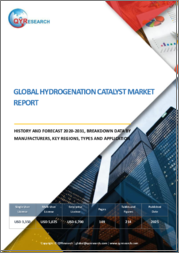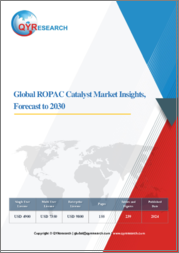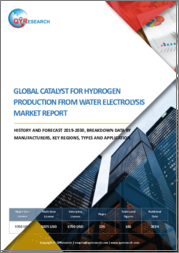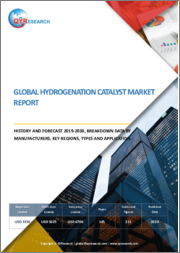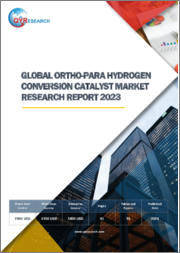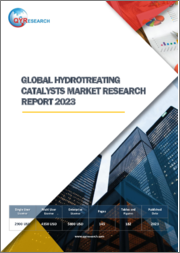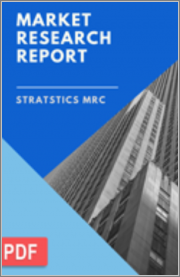
|
시장보고서
상품코드
1446791
세계의 수소화 촉매 시장(2024-2031년)Global Hydrogenation Catalyst Market - 2024-2031 |
||||||
개요
세계의 수소화 촉매 시장은 2023년에 37억 달러로 평가되었고, 2031년에는 52억 달러에 도달할 것으로 예측되며, 예측 기간 2024년부터 2031년까지 CAGR은 4.2%로 성장할 전망입니다.
석유화학 및 에너지 산업에서 환경 친화적이고 생산성이 높은 공정에 대한 요구가 증가함에 따라 촉매 산업의 중요한 부분 집합인 세계의 수소화 촉매 시장 성장이 이어지고 있습니다. 수소생성용 촉매는 특히 공업운전이나 정제용도에서의 수소화 반응에 필수적입니다.
세계의 정제 및 화학 산업의 성장에 수소화 촉매 시장도 꾸준히 성장하고 있습니다. 기술 개발, 엄격한 환경법, 보다 환경 친화적이고 효과적인 수소 생성 방법으로의 전환이 시장을 정의하고 있습니다. 유럽 제조업체들은 수소화 촉매의 효율성과 효율성을 향상시키기 위한 연구 개발에 중점을 두고 있는 것으로 유명합니다. 촉매 기술의 진보는 선택성을 높이고 에너지 사용량을 줄이고 성능을 향상시킬 수 있습니다.
예를 들어, 2022년 10월 4일 독일에 본사를 두고 있는 BASF는 2개의 혁신적인 제품 라인업을 갖추고, 잘 알려진 선택적 수소화 촉매 E 15x 시리즈를 완성했습니다. 새로운 내황성 E 15x S 촉매 시리즈는 오염된 원료의 처리를 용이하게 하고 신뢰할 수 있는 공정 운전을 가능하게 함으로써 불순물 수준이 높은 저품질 원료를 사용하는 생산자의 유연성을 향상시키기 위한 것입니다. 'E 153 S ECU 1/8'은 현재 세계적인 PyGas 1단 유닛에 탑재되어 있어, 그 뛰어난 활동을 실증해, 경쟁사의 현행 촉매를 능가하고 있습니다. 그 때문에 유럽은 이 지역의 제품 시장에서 큰 점유율을 얻고 시장 성장에 기여하고 있습니다.
역학
석유 정제 제품에서 수요 증가
프리미엄, 깨끗한 연료에 대한 세계 수요 증가가 효과적인 수소화 촉매 수요를 밀어 올리고 있습니다. 석유 정제 제품 수요 증가에 대응하기 위해 정유소가 증가하고 있습니다. 이러한 조업을 지원하기 위해 처리장치의 신설이나 기존의 처리장치의 개수가 빈번히 필요하고, 수소화 촉매의 필요성이 높아지고 있습니다.
예를 들어, 2022년 2월, 현대 케미칼스가 운영하는 heavy-feed petrochemical complex(HPC)는 Shell Catalysts& Technologies(SC&T)의 C2 FE 선택적 수소화 촉매를 사용하며, 2021년 12월 신속 그리고 성공적인 스타트업을 확보했습니다. 이 시설은 현대 Chemicals 최초의 중질 원료용 유리 루트 에틸렌 크래커로 연간 750킬로톤(KTA)의 생산이 가능하며 한국의 대산에 위치하고 있습니다. 나프타, 탈아스팔트 처리 오일, 현대 오일 뱅크가 현재 사용하고 있는 정유소로부터의 오프 가스 등 다양한 원료를 처리할 수 있습니다.
능력 확장의 필요성
생산 능력을 확대하는 기업은 시장 점유율을 확대할 기회가 있습니다. 대규모 프로젝트 계약 획득, 고객 기반 확대, 새로운 지역에 대한 서비스 제공은 모두 생산 능력의 증강에 의해 가능해 시장 전체를 밀어 올립니다. 생산 능력 증가는 종종 규모의 경제를 초래하며, 생산자는 수소화 촉매를 단위당 보다 저렴하게, 보다 효과적으로 제조할 수 있습니다. 고객은 이 비용 효과적인 혜택을 받고 촉매 시장 경쟁력을 높이고 더 많은 섭취를 촉진할 수 있습니다.
예를 들어, 에보닉 촉매는 2023년 3월 독일 하나우와 인도의 뭄바이에 가까운 동비브리에 위치한 생산 시설에서 활성화 니켈 분말 촉매의 생산량을 늘릴 계획을 발표했습니다. 이 제품은 KALCAT 및 Metalyst 브랜드 이름으로 판매됩니다. 고객공급 안정성을 향상시키고 귀금속을 사용하지 않는 분말 수소화 촉매에 대한 제약, 농약, 설탕 대체 산업에서의 수요 증가에 대응하기 위해, 에보닉 촉매는 행동을 일으키고 있습니다.
수소의 가용성 및 비용
수소화 처리에는 반응 수소가 대량으로 필요하게 되는 경우가 많습니다. 수소화 공정의 전반적인 경제성은 수소 제조 비용에 크게 영향을 받을 수 있습니다. 수소 제조 비용은 수소화 공정의 전체 비용을 증가시킬 수 있으며, 산업계가 수소화 공정을 채택하는 것을 망설이게 합니다.
잠재적인 한계 중 하나는 수소 공급망의 신뢰성 및 가용성입니다. 수소의 제조, 저장 및 운송 문제는 수소화 촉매에 의존하는 산업 공정을 중단시킬 수 있습니다. 수소화 기술을 널리 적용하려면 강력하고 효과적인 수소 인프라를 구축해야 합니다.
규제상의 장애물
엄격한 규제 기준을 충족하기 위해서는 기술과 절차, 때로는 인프라에 이르기까지 대규모 투자가 필요합니다. 기업은 컴플라이언스를 유지하기 위해 상당한 노력을 기울여야 하지만, 이는 영업 비용을 증가시키고 수익성과 경쟁에 타격을 줄 수 있습니다. 엄격한 규제로 인해 제품과 서비스가 시장에 나설 때까지 시간이 걸릴 수 있습니다. 규제 당국의 승인과 규정 준수 절차에 시간이 걸리기 때문에 신제품 및 신기술 출시가 지연될 수 있습니다. 이 지연으로 인해 규제가 느슨한 지역의 경쟁자가 서로 우위를 차지할 수 있습니다.
목차
제1장 조사 방법 및 조사 범위
제2장 정의 및 개요
제3장 주요 요약
제4장 시장 역학
- 영향요인
- 성장 촉진요인
- 석유 정제 제품 수요 증가
- 생산 능력 확대의 필요성
- 억제요인
- 수소의 가용성 및 비용
- 규제상의 장애물
- 기회
- 영향 분석
- 성장 촉진요인
제5장 산업 분석
- Porter's Five Forces 분석
- 공급망 분석
- 가격 분석
- 규제 분석
- 러시아와 우크라이나 전쟁의 영향 분석
- DMI의 견해
제6장 COVID-19 분석
제7장 제품별
- 귀금속계 수소화 촉매
- 공통 금속 기반 수소화 촉매
- 합금 베이스
제8장 형상별
- 균일계 촉매
- 불균일계 촉매
제9장 최종 사용자별
- 석유 및 가스
- 화학
- 의약품
- 석유화학
- 폴리머
- 기타
제10장 지역별
- 북미
- 미국
- 캐나다
- 멕시코
- 유럽
- 독일
- 영국
- 프랑스
- 이탈리아
- 러시아
- 기타 유럽
- 남미
- 브라질
- 아르헨티나
- 기타 남미
- 아시아태평양
- 중국
- 인도
- 일본
- 호주
- 기타 아시아태평양
- 중동 및 아프리카
제11장 경쟁 구도
- 경쟁 시나리오
- 시황 및 점유율 분석
- M&A 분석
제12장 기업 프로파일
- BASF
- 기업 개요
- 제품 포트폴리오 및 설명
- 재무 개요
- 주요 발전
- Evonik Industries
- Sinopec
- CNPC
- Johnson Matthey
- Royal Dutch Shell
- Clariant
- Albemarle Corporation
- LyondellBasell Industries Holdings BV
- Advanced Refining Technologies(ART)
제13장 부록
AJY 24.03.21Overview
Global Hydrogenation Catalyst Market reached US$ 3.7 billion in 2023 and is expected to reach US$ 5.2 billion by 2031, growing with a CAGR of 4.2% during the forecast period 2024-2031.
The growing need for ecologically friendly and productive processes in the petrochemical and energy industries is driving the growth of the global hydrogeneration catalyst market, a significant subset of the catalyst industry. Catalysts for hydrogen generation are essential for hydrogenation reactions, especially in industrial operations and refining applications.
With the global refining and chemical industries growing, the hydrogeneration catalyst market has been steadily growing. Technological developments, strict environmental laws and a move towards greener and more effective hydrogeneration methods define the market. European producers are renowned for their emphasis on R&D to improve the efficacy and efficiency of hydrogenation catalysts. Catalyst technology advancements can boost selectivity, lower energy usage and enhance performance, all of which can propel market expansion.
For instance, on October 4, 2022, with two innovative product lines, German-based, BASF completes its well-known selective hydrogenation catalyst E 15x series. The new sulfur-resistant E 15x S catalyst series intends to increase producers' flexibility to employ low-quality feedstocks with higher impurity levels by making it easier to process contaminated feedstocks and enabling dependable process operation. The E 153 S ECU 1/8" is currently installed in a global PyGas 1st stage unit, demonstrating its exceptional activity and surpassing the current catalyst of the competitor. Therefore, Europe contributes to the growth of the regional product market with significant regional market share.
Dynamics
Rising Demand from Refined Petroleum Product
The rising global demand for premium and cleaner fuels is driving up the demand for the effective hydrogenation catalysts. In order to keep up with the increasing demand for refined petroleum products and refineries are increasing. To support these operations, this expansion frequently requires for the construction of new processing units or the renovation of existing ones, which increases the need for hydrogenation catalysts.
For instance, in February 2022, the heavy-feed petrochemical complex (HPC), run by Hyundai Chemicals, used the C2 FE selective hydrogenation catalyst from Shell Catalysts & Technologies (SC&T) to ensure a quick and successful startup in December 2021. The facility is Hyundai Chemicals' first heavy-feed grassroot ethylene cracker, capable of producing 750 kilotons per year (KTA) and it is situated in Daesan, South Korea. It can process a variety of feedstocks, including naphtha, processed deasphalted oil and refinery off-gas from the refinery that Hyundai Oilbank currently uses.
Imperative of Capacity Expansion
Companies that increase their production capacity have the chance to take up more market share. Gaining contracts for major projects, expanding their customer base and serving new geographical areas are all made possible by their increased capacity, which boosts the market as a whole. Increased capacity frequently results in economies of scale, which enable producers to create hydrogenation catalysts more cheaply and effectively per unit. Customers may benefit from this cost-effectiveness, increasing the catalysts' competitiveness in the market and encouraging more uptakes.
For instance, in March 2023, at its production facilities in Hanau, Germany and Dombivli, close to Mumbai, India, Evonik Catalysts announced plans to increase the amount of activated nickel powder catalysts it can produce. The products are sold under the KALCAT and Metalyst identities. To improve supply security for its clients and meet the increased demand from the pharmaceutical, agrochemical and sugar replacement industries for its precious metal-free powder hydrogenation catalysts, the business is taking action.
Availability and Cost of Hydrogen
Reactant hydrogen is frequently needed in large quantities for hydrogenation procedures. The overall economics of a hydrogenation process can be significantly impacted by the cost of creating hydrogen. The expense of producing hydrogen may increase the whole cost of the hydrogenation process, which deters industries from adopting it.
One potential limitation is the hydrogen supply chain's dependability and availability. Hydrogen production, storage and transportation issues could cause industrial processes that depend on hydrogenation catalysts to be disrupted. The widespread application of hydrogenation technology requires the establishment of a strong and effective hydrogen infrastructure.
Regulatory Hurdles
It is frequently necessary to make large investments in technology, procedures and occasionally even infrastructure to meet strict regulatory criteria. Businesses may have to commit significant efforts to maintaining compliance, which increases operating expenses and may hurt profitability and competition. Products and services may take longer to reach the market as a result of strict regulatory restrictions. The lengthy regulatory approval and compliance procedures might cause a delay in the release of new goods and technology. Due to this delay, rivals from areas with laxer regulations can have an advantage over one another.
Segment Analysis
The global hydrogenation catalyst market is segmented based on production, form, end-user and region.
Growing Need for Hydrogenation Catalysts Is Caused by Increasing Complexity in Hydrocarbon Extraction from Shale Resources
The extraction of hydrocarbons has become complex due to the emergence of shale oil and gas resources. The market for hydrogenation catalysts has grown as a result of the function hydrogenation catalysts play in upgrading and processing these non-traditional hydrocarbons to fulfill product standards.
In September 2020, with enhanced performance features, a new range of commercially proven alumina catalysts is now available that can help with selective hydrogenation applications like diene selective hydrogenation in C4 olefin streams or first-stage PYGAS. The E14x series of Pd alumina catalysts, which have been used commercially for more than thirty years in selective hydrogenation applications, are replaced by the new series of Pd on spherically shaped E15x catalysts. Therefore, burgeoning demand from oil and gas end-user segment captures the significant shares in the total global segmental shares.
Geographical Penetration
Due to Expanding Refinery Capacities and Growing Demand for Cleaner Fuels, Asia-Pacific Leads the Global Market
Alongside the Asia-Pacific's increased energy needs is a growing need for refined products. To accommodate the growing demand for cleaner fuels, several countries in the region are increasing the capacity of their refineries. Catalysts for hydrogenation are crucial for refining procedures including desulfurization and hydrocracking, which supports market expansion.
For instance, in 2022, Sinopec's first 10,000-ton hydrogenation catalyst production base was completed on 30 March with the successful production of the first batch of approved products by Catalyst Dalian Company's fourth production line. The industry has seen a sharp rise in demand for hydrogenation catalysts in recent years. Therefore, Asia-Pacific is leading the global hydrogenation catalyst market with majority of the global market shares.
COVID-19 Impact Analysis
The supply chain for catalyst components or the catalysts themselves may have been impacted by movement restrictions, lockdowns and transportation interruptions. The epidemic caused a temporary delay or shutdown in a number of companies, including petrochemicals and refining. The need for hydrogenation catalysts may have declined as a result of this. The pandemic's uncertainty may have delayed or postponed project implementations and investment decisions, which has an effect on the market for catalysts.
Price instability was caused by changes in supply and demand, which affected the hydrogenation catalyst market among other markets. Market volatility was caused on by uncertainties over the scope and duration of the epidemic, which had an impact on industry participants' profit margins and pricing policies.
Russia-Ukraine War Impact Analysis
Supply chains in the area have been affected by the conflict between Russia and Ukraine since Russia is a significant producer of precious metals in Europe, including palladium and platinum, which are essential ingredients in catalysts. Geopolitical tensions, border closures and trade restrictions have impeded the free transit of these metals, disrupted supply chains and lowered the availability of raw materials for the creation of catalysts.
The conflict between Russia and Ukraine has caused price instability for precious metals, especially those used in catalysts, on the market. Palladium and platinum prices have fluctuated due to geopolitical unrest, political tensions and the possibility of supply disruptions. Effective planning and budgeting can be challenging for customers and catalyst producers as a result of these price changes.
By Product
- Precious Metal Based Hydrogenation Catalyst
- Common Metal Based Hydrogenation Catalyst
- Alloy Based Hydrogenation Catalyst
By Form
- Homogenous Catalyst
- Heterogenous Catalyst
By End-User
- Oil and Gas
- Chemical
- Pharmaceuticals
- Petrochemicals
- Polymer
- Others
By Region
- North America
- U.S.
- Canada
- Mexico
- Europe
- Germany
- UK
- France
- Italy
- Russia
- Rest of Europe
- South America
- Brazil
- Argentina
- Rest of South America
- Asia-Pacific
- China
- India
- Japan
- Australia
- Rest of Asia-Pacific
- Middle East and Africa
Key Developments
- On April 12, 2023, at its production facilities in Hanau, Germany and Dombivli, close to Mumbai, India, Evonik Catalysts announced plans to increase the amount of activated nickel powder catalysts it can produce.
- In 2022, Sinopec's first 10,000-ton hydrogenation catalyst production base was completed on 30 March with the successful production of the first batch of approved products by Catalyst Dalian Company's fourth production line.
- In 2021, Axens announced the opening of SeLene, a brand-new family business specializing in selective hydrogenation. One of the most important purification processes to generate the most important petrochemical industry building blocks is selective hydrogenation.
Competitive Landscape
The major global players in the market include BASF, Evonik Industries, Sinopec, CNPC, Johnson Matthey, Royal Dutch Shell, Clariant, Albemarle Corporation, LyondellBasell Industries Holdings B.V. and Advanced Refining Technologies (ART).
Why Purchase the Report?
- To visualize the global hydrogenation catalyst market segmentation based on production, form, end-user and region, as well as understands key commercial assets and players.
- Identify commercial opportunities by analyzing trends and co-development.
- Excel data sheet with numerous data points of hydrogenation catalyst market-level with all segments.
- PDF report consists of a comprehensive analysis after exhaustive qualitative interviews and an in-depth study.
- Product mapping available as excel consisting of key products of all the major players.
The global hydrogenation catalyst market report would provide approximately 61 tables, 54 figures and 175 Pages.
Target Audience 2024
- Manufacturers/ Buyers
- Industry Investors/Investment Bankers
- Research Professionals
- Emerging Companies
Table of Contents
1. Methodology and Scope
- 1.1. Research Methodology
- 1.2. Research Objective and Scope of the Report
2. Definition and Overview
3. Executive Summary
- 3.1. Snippet by Product
- 3.2. Snippet by Form
- 3.3. Snippet by End-User
- 3.4. Snippet by Region
4. Dynamics
- 4.1. Impacting Factors
- 4.1.1. Drivers
- 4.1.1.1. Rising Demand from Refined Petroleum Product
- 4.1.1.2. Imperative of Capacity Expansion
- 4.1.2. Restraints
- 4.1.2.1. Availability and Cost of Hydrogen
- 4.1.2.2. Regulatory Hurdles
- 4.1.3. Opportunity
- 4.1.4. Impact Analysis
- 4.1.1. Drivers
5. Industry Analysis
- 5.1. Porter's Five Force Analysis
- 5.2. Supply Chain Analysis
- 5.3. Pricing Analysis
- 5.4. Regulatory Analysis
- 5.5. Russia-Ukraine War Impact Analysis
- 5.6. DMI Opinion
6. COVID-19 Analysis
- 6.1. Analysis of COVID-19
- 6.1.1. Scenario Before COVID
- 6.1.2. Scenario During COVID
- 6.1.3. Scenario Post COVID
- 6.2. Pricing Dynamics Amid COVID-19
- 6.3. Demand-Supply Spectrum
- 6.4. Government Initiatives Related to the Market During Pandemic
- 6.5. Manufacturers Strategic Initiatives
- 6.6. Conclusion
7. By Product
- 7.1. Introduction
- 7.1.1. Market Size Analysis and Y-o-Y Growth Analysis (%), By Product
- 7.1.2. Market Attractiveness Index, By Product
- 7.2. Precious Metal Based Hydrogenation Catalyst*
- 7.2.1. Introduction
- 7.2.2. Market Size Analysis and Y-o-Y Growth Analysis (%)
- 7.3. Common Metal Based Hydrogenation Catalyst
- 7.4. Alloy Based
8. By Form
- 8.1. Introduction
- 8.1.1. Market Size Analysis and Y-o-Y Growth Analysis (%), By Form
- 8.1.2. Market Attractiveness Index, By Form
- 8.2. Homogenous Catalyst*
- 8.2.1. Introduction
- 8.2.2. Market Size Analysis and Y-o-Y Growth Analysis (%)
- 8.3. Heterogenous Catalyst
9. By End-User
- 9.1. Introduction
- 9.1.1. Market Size Analysis and Y-o-Y Growth Analysis (%), By End-User
- 9.1.2. Market Attractiveness Index, By End-User
- 9.2. Oil and Gas*
- 9.2.1. Introduction
- 9.2.2. Market Size Analysis and Y-o-Y Growth Analysis (%)
- 9.3. Chemical
- 9.4. Pharmaceuticals
- 9.5. Petrochemicals
- 9.6. Polymer
- 9.7. Others
10. By Region
- 10.1. Introduction
- 10.1.1. Market Size Analysis and Y-o-Y Growth Analysis (%), By Region
- 10.1.2. Market Attractiveness Index, By Region
- 10.2. North America
- 10.2.1. Introduction
- 10.2.2. Key Region-Specific Dynamics
- 10.2.3. Market Size Analysis and Y-o-Y Growth Analysis (%), By Product
- 10.2.4. Market Size Analysis and Y-o-Y Growth Analysis (%), By Form
- 10.2.5. Market Size Analysis and Y-o-Y Growth Analysis (%), By End-User
- 10.2.6. Market Size Analysis and Y-o-Y Growth Analysis (%), By Country
- 10.2.6.1. U.S.
- 10.2.6.2. Canada
- 10.2.6.3. Mexico
- 10.3. Europe
- 10.3.1. Introduction
- 10.3.2. Key Region-Specific Dynamics
- 10.3.3. Market Size Analysis and Y-o-Y Growth Analysis (%), By Product
- 10.3.4. Market Size Analysis and Y-o-Y Growth Analysis (%), By Form
- 10.3.5. Market Size Analysis and Y-o-Y Growth Analysis (%), By End-User
- 10.3.6. Market Size Analysis and Y-o-Y Growth Analysis (%), By Country
- 10.3.6.1. Germany
- 10.3.6.2. UK
- 10.3.6.3. France
- 10.3.6.4. Italy
- 10.3.6.5. Russia
- 10.3.6.6. Rest of Europe
- 10.4. South America
- 10.4.1. Introduction
- 10.4.2. Key Region-Specific Dynamics
- 10.4.3. Market Size Analysis and Y-o-Y Growth Analysis (%), By Product
- 10.4.4. Market Size Analysis and Y-o-Y Growth Analysis (%), By Form
- 10.4.5. Market Size Analysis and Y-o-Y Growth Analysis (%), By End-User
- 10.4.6. Market Size Analysis and Y-o-Y Growth Analysis (%), By Country
- 10.4.6.1. Brazil
- 10.4.6.2. Argentina
- 10.4.6.3. Rest of South America
- 10.5. Asia-Pacific
- 10.5.1. Introduction
- 10.5.2. Key Region-Specific Dynamics
- 10.5.3. Market Size Analysis and Y-o-Y Growth Analysis (%), By Product
- 10.5.4. Market Size Analysis and Y-o-Y Growth Analysis (%), By Form
- 10.5.5. Market Size Analysis and Y-o-Y Growth Analysis (%), By End-User
- 10.5.6. Market Size Analysis and Y-o-Y Growth Analysis (%), By Country
- 10.5.6.1. China
- 10.5.6.2. India
- 10.5.6.3. Japan
- 10.5.6.4. Australia
- 10.5.6.5. Rest of Asia-Pacific
- 10.6. Middle East and Africa
- 10.6.1. Introduction
- 10.6.2. Key Region-Specific Dynamics
- 10.6.3. Market Size Analysis and Y-o-Y Growth Analysis (%), By Product
- 10.6.4. Market Size Analysis and Y-o-Y Growth Analysis (%), By Form
- 10.6.5. Market Size Analysis and Y-o-Y Growth Analysis (%), By End-User
11. Competitive Landscape
- 11.1. Competitive Scenario
- 11.2. Market Positioning/Share Analysis
- 11.3. Mergers and Acquisitions Analysis
12. Company Profiles
- 12.1. BASF*
- 12.1.1. Company Overview
- 12.1.2. Product Portfolio and Description
- 12.1.3. Financial Overview
- 12.1.4. Key Developments
- 12.2. Evonik Industries
- 12.3. Sinopec
- 12.4. CNPC
- 12.5. Johnson Matthey
- 12.6. Royal Dutch Shell
- 12.7. Clariant
- 12.8. Albemarle Corporation
- 12.9. LyondellBasell Industries Holdings B.V.
- 12.10. Advanced Refining Technologies (ART)
LIST NOT EXHAUSTIVE
13. Appendix
- 13.1. About Us and Services
- 13.2. Contact Us






